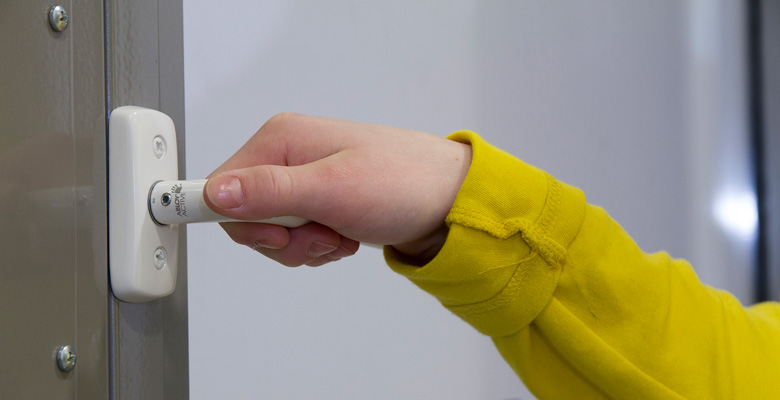Antimicrobial coatings in public spaces reduce the spread of infections and save money
A large number of infectious diseases are transmitted via contact surfaces in public spaces. Antimicrobial paints are ideal for facilities with high hygiene standards, such as hospitals, schools, kindergartens, and homes for the elderly, to help reduce microbial populations on contact surfaces. Antimicrobial coatings can be applied to, for example, door handles, arm supports, railings, faucets, vents, furniture, and walls, all of which serve as vehicles for microbes.
Studies have shown that antimicrobial space solutions have reduced the number of infections by as much as 80 percent. Avoiding infectious diseases also brings cost savings in multiple ways, reducing for example medical costs and costs to employers due to absences.
Fewer colds in school children in the classroom
Through its customers, Teknos has been involved in several locations with high hygiene standards. Independent tests have shown that antimicrobial space solutions have reduced the number of infections in a hospital environment.
Antimicrobial space solutions were tested in the school context. A classroom in a school in southern Finland was equipped with Isku's furniture that was painted with Teknos antimicrobial coatings. Absences due to illness were reduced by 52 percent in the tested classroom in comparison with a reference classroom where the furniture was not replaced.
Avoiding infectious diseases brings savings and is in everyone's interest
Microbes accumulating on various surfaces, particularly in public spaces, spread through contact from one place and person to another, transmitting infectious diseases. Colds, influenzas, Norovirus, and the majority of causes of hospital infections, such as MRSA, ESBL, and VRE, are transmitted via contact. (Duodecim Terveyskirjasto Health Library, 2019.)
The reduction of infectious diseases brings substantial savings, in many ways, to society and to employers. Avoiding diseases means fewer absences and reduced need for care.
The group of companies in the growing HygTech Alliance together provide antimicrobial space solutions
A manufacturer of antimicrobial coatings, Teknos is part of HygTech Alliance. The group also includes Isku, a supplier of antimicrobial furniture and designer of public spaces, Oras, manufacturer of touchless sanitary fittings, Korpinen, manufacturer of antimicrobial bathroom furnishings, Abloy, manufacturer of antimicrobial architectural hardware, Lojer Group, manufacturer of medical furniture, and the latest member, Led Tailor Innovation, manufacturer of photon disinfection lights.
Cooperation between the different parties provides the best know-how on how to make public spaces more hygienic as all essential contact surfaces can be provided as antimicrobial surfaces.
The Alliance aims to play its part in supporting work to prevent infectious diseases, and it has organized several training events for designers, developers, and builders who are involved in hospital projects.
A paint surface actively reduces microbial populations
The effect of antimicrobial paint is based on silver phosphate glass added to the paint. It is distributed throughout the paint's composition. This ingredient of the paint actively destroys bacterial growth and prevents bacterial division. The antibacterial effect of the coating will last as long as any paint remains, as the antimicrobial active ingredient is distributed throughout the paint. Scratches and surface wear do not adversely affect the paint's antimicrobial properties.
Antimicrobial substances have long been recognized, and the antimicrobial functionality of the paint additive silver phosphate glass, based on the BioCote® technology, has been tested according to the ISO 22196 standard. According to the standard, the bacterial count should be reduced by 99.99% in 24 hours.
The destruction of microbes begins as soon as microbes attach themselves to the surface. After one hour, approximately 50 percent of the population has been destroyed and in two hours the count is halved again. After 24 hours, 99.99% of the microbes have been destroyed.
Antimicrobial paint surfaces and cleaning
The paint's antimicrobial property is not diminished by the detergents and cleaning methods used in hospitals. This has been tested in laboratory tests using the same Kiilto Oy cleaning and washing chemicals that are used in Finnish hospitals. Powder coated surfaces can be cleaned and disinfected without the antimicrobial property being adversely affected. Antimicrobial surfaces work 24/7, i.e., this property keeps surfaces actively clean between clean-ups. However, regular cleaning should still be kept up, because antimicrobial surfaces require periodic cleaning for the additive in the paint to function. Therefore, surfaces must not be waxed or otherwise coated, as this would prevent the additive from coming into contact with microbes.
The antimicrobial property does not limit the paint's range of colours
Antimicrobial paint looks good and meets the high standards of quality and appearance.
Designed for all concrete, plaster, and construction board surfaces, the antimicrobial TIMANTTI CLEAN is suitable for wall and ceiling surfaces.
Antimicrobial powder paints are suitable for painting metal items. INFRALIT EP/PE 8235 epoxy polyester powder paint is suitable for steel and aluminum surfaces and is available in several different colours as gloss (90), semi-gloss (75) and matt (30). Standard colours are white, black, and silver.
Previously painted metal surfaces can be rendered antimicrobial by using the full-gloss (95) INFRALIT PE 8435-10 polyester powder varnish. Powder varnish can be used in the same way as ordinary powder paints, either directly on metal or sprayed over a powder paint film.

